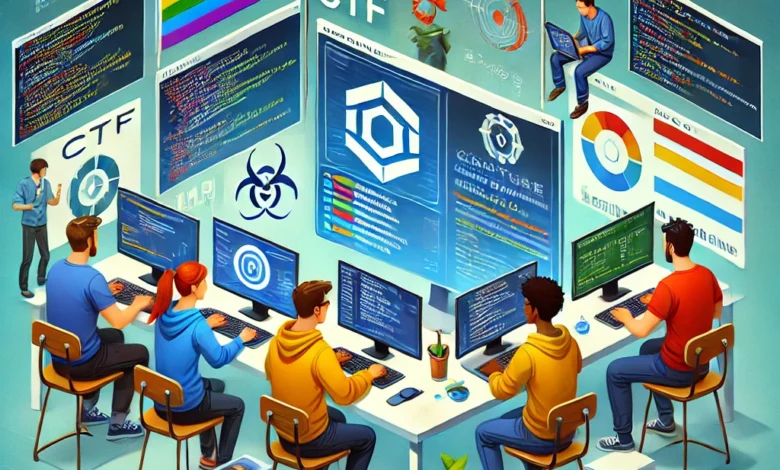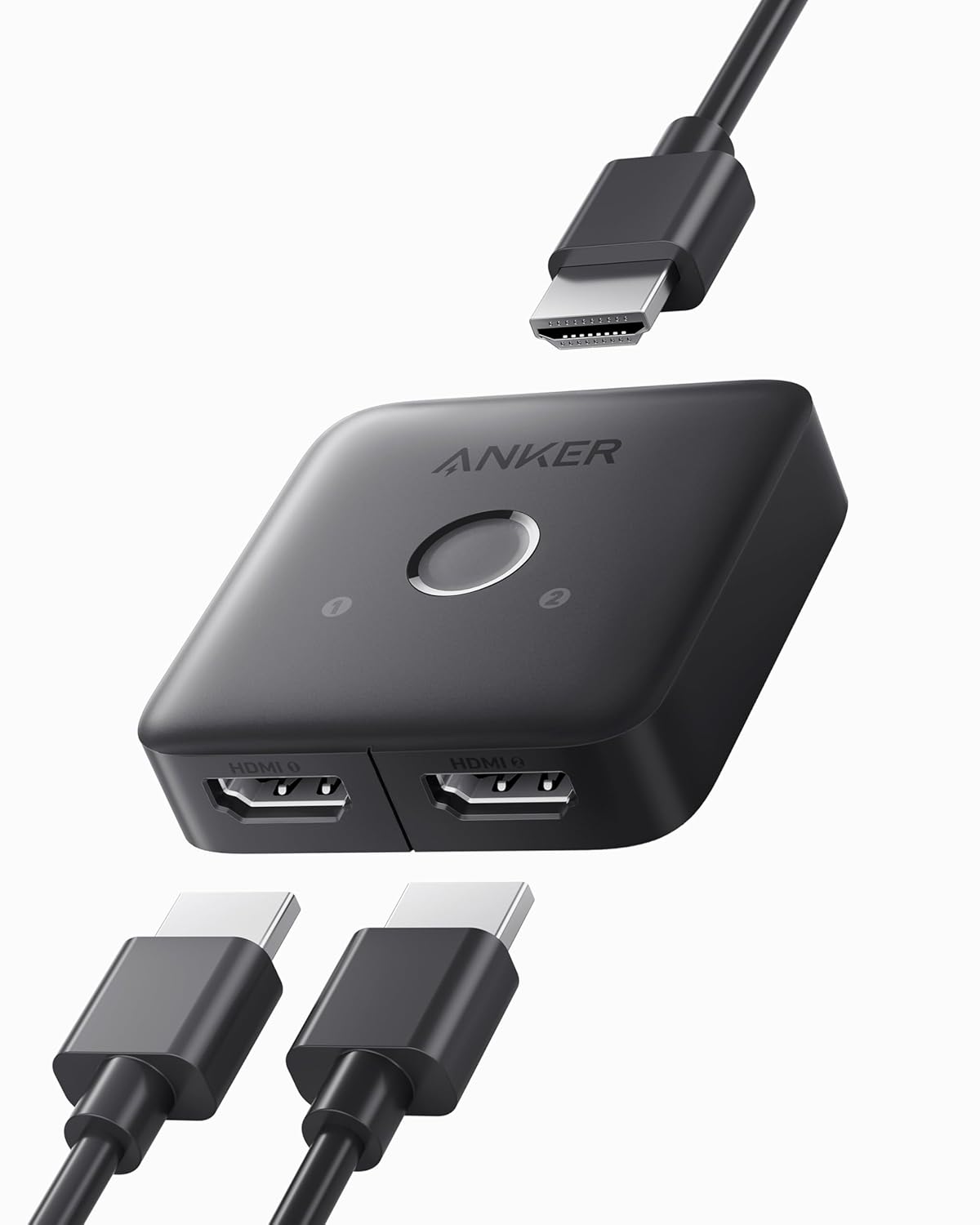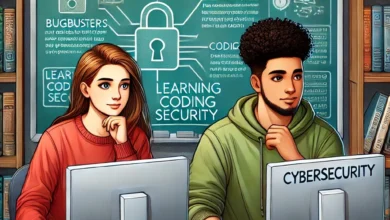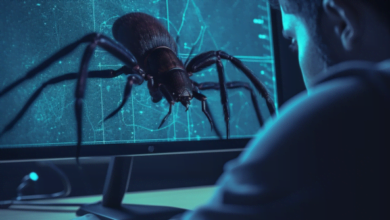Dive into Capture the Flag (CTF) Competitions
Level Up Your Cyber Skills with Fun and Play

Hey, BugBusters! Have you ever considered hacking as a game? Welcome to the world of Capture the Flag (CTF) competitions! These events are the perfect blend of fun and learning, designed to boost your cybersecurity skills while you enjoy the thrill of a challenge. Let’s dive into what CTF competitions are all about and why they’re a must-try for anyone interested in cybersecurity.
Defining CTF Competitions: Capture the Flag competitions are cybersecurity contests in which participants solve challenges to capture “flags”—bits of data hidden within intentionally vulnerable programs or systems. Think of them as digital treasure hunts, where the treasure is valuable security knowledge.
CTFs come in two primary flavors:
- Jeopardy-style CTFs: These are structured like a game show. You have various categories of challenges, each with different difficulty levels. Solve the challenge, capture the flag, and earn points. Categories can include cryptography, web exploitation, reverse engineering, and more.
- Attack-defense CTFs simulate real-world hacking scenarios. Teams defend their servers while attacking others. It’s a dynamic battle in which offense and defense skills are tested simultaneously.
Role in the Cybersecurity Community: CTF competitions are more than just games; they are integral to cybersecurity. They provide a platform for aspiring ethical hackers to test their skills in a controlled, legal environment. Seasoned professionals also participate to stay sharp and explore new vulnerabilities and attack vectors.
Developing Practical Skills: Participating in CTFs equips you with hands-on experience that is invaluable in cybersecurity. You learn to:
- Think Like a Hacker: Understand attackers’ mindset and techniques to exploit vulnerabilities.
- Problem-Solve Under Pressure: Challenges simulate real-world scenarios, pushing you to think critically and act swiftly.
- Collaborate and Communicate: Many CTFs encourage teamwork, enhancing your ability to work effectively with others.
Understanding Cybersecurity Concepts: CTFs are educational goldmines. Each challenge teaches you something new about cybersecurity, whether it’s a specific vulnerability, a novel exploit technique, or a cryptographic method. By participating, you deepen your knowledge of cybersecurity fundamentals and stay updated with the latest in the field.
So, are you ready to join the ranks of cyber warriors and capture some flags? Whether you’re a total newbie or a seasoned pro, CTF competitions offer a fun and engaging way to hone your skills. Next up, let’s explore the benefits of participating in these thrilling events. Stay tuned, BugBusters!
Benefits of Participating in CTFs
Now that you know what Capture the Flag (CTF) competitions are, let’s explore why you should get involved. Whether you’re just starting out in cybersecurity or looking to sharpen your skills, CTFs offer a wealth of benefits. From developing critical thinking to providing hands-on experience, these competitions are a treasure trove of learning opportunities. Here’s why you should jump in and start capturing those flags!
Develop Critical Thinking: CTFs challenge you to think outside the box. Each problem requires a unique solution, pushing you to analyze situations differently. You’ll encounter puzzles that test your logic, creativity, and ingenuity, helping you build a robust problem-solving mindset essential for any cybersecurity professional.
Enhance Problem-Solving Skills: In CTFs, every challenge is like a riddle waiting to be solved. You’ll learn how to break down complex problems into manageable pieces, devise strategies, and apply your knowledge in real-time. This experience is invaluable in cybersecurity, where quick, effective problem-solving can make all the difference.
Boost Teamwork Skills: Many CTF competitions are team-based, fostering collaboration and communication. You’ll work with others, share insights, and develop strategies together. This teamwork enhances your social and professional skills and mirrors the collaborative environment of real-world cybersecurity projects.
Gain Practical, Hands-On Experience: CTFs are designed to simulate real-world security challenges. Participating gives you hands-on experience with tools, techniques, and vulnerabilities you might encounter in the field. This practical knowledge is crucial for understanding how theoretical concepts apply in real scenarios, giving you a head start in your cybersecurity career.
Enjoy Fun and Engaging Learning: One of the best parts of CTFs is the fun factor! These competitions turn learning into a game, making it enjoyable and engaging. The excitement of solving challenges, earning points, and seeing your name on the leaderboard keeps you motivated and eager to learn more. Plus, the community aspect of CTFs adds to the enjoyment as you share the thrill of competition with fellow enthusiasts.
Motivation for Continuous Learning: CTFs are addictive in the best way possible. The more you play, the more you learn and the more you want to improve. This continuous cycle of learning and challenge helps you stay updated with the latest in cybersecurity and drives your personal and professional growth.
So, why wait? Dive into the world of CTFs and start reaping these incredible benefits. Next, we’ll guide you on where to find beginner-friendly CTFs to kickstart your journey. Let’s get ready to level up, BugBusters!
Finding Beginner-Friendly CTFs
Ready to jump into the world of Capture the Flag (CTF) competitions but not sure where to start? No worries—we’ve got you covered. There are plenty of beginner-friendly CTFs out there designed to help you get your feet wet and build your skills. Let’s explore some top platforms and communities where you can find these competitions, and get tips on choosing the right one for you.
Websites and Platforms for Beginner-Friendly CTFs:
- CTFtime.org:
- Overview: This is the go-to hub for CTF competitions. CTFtime.org lists upcoming events worldwide, complete with details and ratings.
- Why It’s Great: You can filter events by difficulty level, making it easy to find beginner-friendly options. Plus, you can join or form teams to participate in events.
- OverTheWire:
- Overview: OverTheWire offers wargames designed to teach you various aspects of cybersecurity through fun and challenging exercises.
- Why It’s Great: It’s perfect for beginners. The wargames start with basic concepts and gradually increase in difficulty, helping you build your skills step-by-step.
- PicoCTF:
- Overview: Created by Carnegie Mellon University, PicoCTF is an annual cybersecurity competition aimed at middle and high school students, but it’s also a fantastic resource for beginners of any age.
- Why It’s Great: The challenges are designed to be educational and accessible, emphasizing learning.
Community Forums and Social Media Groups:
- Reddit:
- Subreddits: Check out subreddits like r/CTF, r/netsec, and r/hacking. These communities often share information about upcoming CTFs, tips, and resources.
- Why It’s Great: Reddit is a treasure trove of information and a great place to connect with fellow beginners and seasoned pros alike.
- Discord and Slack Groups:
- Overview: Many cybersecurity communities have Discord and Slack channels where members share CTF announcements and resources.
- Why It’s Great: These platforms offer real-time interaction and support, which can be incredibly helpful when you’re stuck on a challenge or need advice.
- GitHub:
- Overview: Search for repositories and discussions related to CTFs on GitHub. Many CTF organizers and participants share challenges, solutions, and resources here.
- Why It’s Great: GitHub is excellent for finding practical resources and code snippets that can aid your learning and participation in CTFs.
Tips for Selecting the Right CTF Competition:
- Match Your Skill Level:
- Advice: Look for competitions specifically labeled as beginner-friendly or designed for newcomers. Avoid jumping into advanced CTFs too soon, as this can be overwhelming and discouraging.
- Check the Topics:
- Advice: Choose CTFs that cover topics you’re interested in or want to learn more about. Whether it’s web security, cryptography, or reverse engineering, finding a competition that aligns with your interests will keep you motivated.
- Team Up:
- Advice: If possible, join a team. Working with others can enhance your learning experience, provide support, and make the competition more enjoyable. Plus, you’ll learn a lot from your teammates.
- Read Reviews and Ratings:
- Advice: Platforms like CTFtime.org allow participants to rate and review CTFs. Reading these reviews can help you gauge the quality and difficulty of a competition before you commit.
- Start Small:
- Advice: Begin with shorter, one-day CTFs to understand the format and pace. As you gain confidence and experience, you can move on to longer, more challenging events.
Finding the right CTF competition is your first step toward becoming a skilled bug bounty hunter. With these resources and tips, you’ll be well on your way to capturing your first flag. Next, let’s discuss how to prepare for your first CTF competition.
Preparing for Your First CTF
BugBusters! So, you’ve found a beginner-friendly CTF competition and are ready to dive in. Awesome! But before jumping into the fray, preparing yourself properly is crucial. Let’s walk through some practical steps to ensure you’re set up for success. We’ve got you covered, from setting up a virtual lab to collaborating with teammates.
Setting Up a Virtual Lab: Before you start, you’ll need a safe environment to practice and test your skills. Here’s how to get started:
- Virtual Machines (VMs): Use software like VirtualBox or VMware to set up isolated environments where you can safely practice without risking your primary system.
- Download and install: Get VirtualBox or VMware from here.
- Create VMs: Set up multiple VMs with different operating systems (Windows, Linux) to simulate various scenarios.
- Kali Linux: This is a go-to OS for penetration testing and comes pre-installed with many security tools.
- Download and Install: Get Kali Linux from here.
Practicing with Past Challenges: One of the best ways to prepare is by solving challenges from past CTFs.
- CTF Archives: Websites like CTFtime.org maintain archives of past CTF challenges. Use these to practice and get a feel for the types of problems you’ll encounter.
- Wargames: Platforms like OverTheWire and Hack The Box offer continuous wargames designed to build your skills.
Learning Essential Tools and Techniques: Familiarize yourself with the tools and techniques commonly used in CTFs.
- Standard Tools: Learn to use tools like Nmap (network scanning), Burp Suite (web vulnerability scanning), Wireshark (network traffic analysis), and John the Ripper (password cracking).
- Resources: Online tutorials and documentation are your best friends. Sites like YouTube, Udemy, and Cybrary offer excellent courses.
- Techniques: Understand basic hacking techniques, such as SQL injection, cross-site scripting (XSS), and buffer overflow.
Understanding the Rules and Objectives: Every CTF has its own set of rules and objectives. Make sure you understand them thoroughly.
- Read the Guidelines: Carefully read the competition’s rules to avoid penalties or disqualification.
- Know the Objectives: Understand what you aim to achieve in each challenge—capturing flags, solving puzzles, or defending systems.
Building a Study Plan: A well-structured study plan can help you stay focused and progress consistently.
- Set Goals: Break down your preparation into manageable goals. For example, spend a week learning Nmap, another week on web vulnerabilities, etc.
- Allocate Time: Dedicate specific times each day or week to practice. Consistency is key.
Collaborating with Teammates: Teamwork can significantly impact your CTF experience.
- Find a Team: Join or form a team with other beginners or more experienced players. Collaboration fosters learning and makes the experience more enjoyable.
- Communicate: Use platforms like Discord or Slack to keep in touch, share tips, and solve problems together.
- Divide and Conquer: Assign team members different challenges based on their strengths. This approach ensures that you cover more ground efficiently.
Following these steps will prepare you to tackle your first CTF competition. Preparation is vital, but keep a positive mindset and have fun. Next, we’ll talk about what to expect during the competition. Let’s get ready to capture some flags, BugBusters!
What to Expect During a CTF Competition
Now that you’re ready for your first CTF competition let’s talk about what to expect on the big day. Understanding the flow of a CTF event and knowing how to handle common challenges will help you stay calm, focused, and effective. Here’s a typical CTF competition breakdown and some tips to ensure you make the most of the experience.
The Typical Structure of a CTF Event:
- Opening Briefing:
- Kickoff: Most CTFs start with an opening briefing, during which organizers explain the rules, objectives, and logistics of the event. This is your chance to get all the necessary information and clarify any doubts.
- Team Check-In: If you’re part of a team, ensure everyone is present and ready. This is the time to finalize your strategy and ensure all team members know their roles.
- Challenge Release:
- Accessing Challenges: Challenges are usually released on a platform where you can see a list of tasks to complete. Each challenge comes with a brief description, point value, and flag submission box.
- Categories: Challenges are typically divided into categories such as Web Exploitation, Cryptography, Forensics, and Reverse Engineering.
- Solving Challenges:
- Getting Started: Begin with the challenges that seem easier or fall within your strengths. This will build confidence and help you score early points.
- Collaborate and Communicate: Keep communication lines open if you’re on a team. Share your findings and help each other troubleshoot problems.
- Common Challenges and How to Tackle Them:
- Technical Hurdles: You might encounter technical difficulties like tool malfunctions or connectivity issues. Have backups ready, and don’t hesitate to ask organizers for help if needed.
- Complex Problems: Some challenges may seem insurmountable at first. Break them down into smaller parts, research similar problems, and keep trying different approaches.
- Time Management: It’s easy to get stuck on one problem for too long. Set time limits for each challenge and move on if you’re not progressing. You can always come back later.
- Managing Time Effectively:
- Prioritize: Focus on high-value challenges that match your strengths but don’t neglect easier ones that can rack up points quickly.
- Stay Organized: Track solved challenges, partial solutions, and pending tasks. Use notes or a spreadsheet to manage your workflow.
- Staying Focused and Handling Pressure:
- Stay Calm: It’s normal to feel pressure, especially if the clock is ticking. Take deep breaths and stay calm. Panic will only slow you down.
- Take Breaks: Short breaks can help refresh your mind. Step away for a few minutes, stretch, hydrate, and come back with a clear head.
- Support Each Other: If you’re in a team, support each other emotionally. Encourage your teammates and maintain a positive atmosphere.
- Final Scoreboard:
- Submission Deadline: Be aware of the deadline for flag submissions. Ensure you submit all your flags before the time runs out.
- Scoreboard Review: The final scoreboard will be posted once the event ends. Review your performance and reflect on what you learned.
Tips for a Successful CTF Experience:
- Preparation: Ensure all your tools and environments are set up and tested before the competition starts.
- Adaptability: Be ready to switch gears if you hit a wall. Flexibility is key to tackling diverse challenges.
- Continuous Learning: Each challenge is a learning opportunity. Take notes on what you learned and where you struggled to improve for the next competition.
Participating in a CTF competition is a fantastic way to sharpen your skills, learn new techniques, and have fun. Stay focused, keep a positive attitude, and remember that every challenge conquered is a step forward in your bug bounty journey. Next up, we’ll discuss the importance of learning through collaboration during these competitions.
Learning Through Collaboration
One of the best parts of participating in Capture the Flag (CTF) competitions is the sense of camaraderie and teamwork. While soloing challenges can be exhilarating, tackling them with a team can amplify your learning and make the experience even more enjoyable. Let’s explore the benefits of collaboration, strategies for effective teamwork, and tips for joining or forming your own CTF team.
Benefits of Working with a Team:
- Sharing Knowledge:
- Collective Expertise: Each team member brings unique skills and knowledge to the table. By pooling your strengths, you can tackle a wider range of challenges more effectively.
- Learning Opportunities: Collaborating with others exposes you to different perspectives and techniques. You can learn a lot from your teammates, whether it’s a new tool, a clever hack, or a different way of approaching a problem.
- Dividing Tasks:
- Efficiency: Splitting up challenges among team members ensures that you can work on multiple tasks simultaneously. This maximizes your efficiency and increases your chances of capturing more flags.
- Focus: Dividing tasks allows each member to focus on areas where they excel. For example, one person can handle cryptography challenges while another tackles web exploits.
- Supporting Each Other:
- Emotional Support: CTFs can be intense, and having a team means you have a built-in support system. Encouragement and positive reinforcement from teammates can boost morale and keep everyone motivated.
- Problem-Solving Together: When you hit a wall, discussing the problem with your team can provide new insights and solutions that you might not have considered alone.
Strategies for Effective Communication and Collaboration:
- Use Communication Tools:
- Platforms: Use platforms like Discord, Slack, or Zoom to communicate in real time. Create channels for different challenge categories to keep discussions organized.
- Voice Calls: Sometimes, talking through a problem can be faster and more effective than typing. Use voice or video calls to brainstorm and solve issues collaboratively.
- Establish Roles:
- Team Roles: Assign roles based on strengths and interests. For example, designate a leader to coordinate efforts, a researcher to gather information and specialists for different types of challenges.
- Task Management: Use tools like Trello or Asana to assign and track tasks. This helps ensure that everyone knows what they’re working on and avoids duplication of effort.
- Regular Check-Ins:
- Updates: Regularly update each other on progress and roadblocks. Short, frequent check-ins can keep everyone on the same page and help quickly address any issues that arise.
- Feedback: Constructive feedback is crucial. Encourage open communication where team members can share what’s working and what’s not and make adjustments as needed.
Joining or Forming a CTF Team:
- Join Existing Teams:
- Communities: Engage with online communities and forums dedicated to cybersecurity and CTFs. Websites like CTFtime.org, Reddit, and GitHub often have postings from teams looking for new members.
- Networking: Attend cybersecurity meetups, workshops, and conferences. These events are great for meeting like-minded individuals and finding potential teammates.
- Form Your Team:
- Friends and Colleagues: Start by contacting friends, classmates, or colleagues who share your interest in cybersecurity. Forming a team with people you already know can be a great way to start.
- Social Media: Use social media platforms to announce your team formation. You might be surprised by how many people are interested in joining you.
- Team Dynamics:
- Inclusivity: Encourage a culture of inclusivity and respect within your team. Every member’s contribution is valuable, and fostering a positive environment will lead to better collaboration.
- Practice Together: Regularly participate in smaller CTFs or practice challenges together to build team cohesion and refine your collaborative strategies.
Collaboration in CTF competitions enhances your problem-solving capabilities and makes the experience more enjoyable and rewarding. By working together, you can achieve more, learn faster, and have much more fun. Next, let’s give some final thoughts and encouragement to start your CTF journey. Get ready to team up and conquer those challenges, BugBusters!
Your CTF Adventure Awaits
We’ve covered a lot of ground in this article, from understanding capture-the-flag (CTF) competitions to preparing for your first event and learning through collaboration. It’s time to take the plunge and start your CTF adventure. Here’s a quick recap of why CTFs are such an amazing way to develop your cybersecurity skills and how you can get started.
Key Takeaways:
- What Are CTFs? CTF competitions are fun, engaging events in which you solve cybersecurity challenges to capture flags. They come in different styles, like Jeopardy and Attack-Defense, and simulate real-world hacking scenarios.
- Benefits of Participating: CTFs help you develop critical thinking, problem-solving, and teamwork skills. They provide hands-on experience with real-world security challenges and make learning enjoyable and motivating.
- Finding Beginner-Friendly CTFs: Plenty of resources are available to find beginner-friendly CTFs, such as CTFtime.org, OverTheWire, PicoCTF, and community forums on Reddit, Discord, and GitHub.
- Preparing for Your First CTF: Effective preparation includes setting up a virtual lab, practicing with past challenges, learning essential tools and techniques, understanding the competition rules, building a study plan, and collaborating with teammates.
- What to Expect During a CTF Competition: CTF events typically start with an opening briefing, followed by solving challenges and managing your time effectively. Staying focused, calm, and supportive of your teammates is crucial.
- Learning Through Collaboration: Working with a team enhances your learning experience, efficiency, and problem-solving capabilities. Effective communication and collaboration strategies are key to a successful team effort.
Join the BugBustersUnited Community: Participating in CTFs is not just about individual learning; it’s about being part of a vibrant community of cybersecurity enthusiasts. We encourage you to join BugBustersUnited, share your experiences, learn from others, and grow together. Whether you’re tackling your first challenge or leading a team to victory, every step you take in the world of CTFs is a step toward becoming a more skilled and confident cybersecurity professional.
Your Journey Begins Now: Remember, the learning journey is ongoing and best enjoyed with others. Don’t be afraid to make mistakes, ask questions, and seek help. Every challenge you face is an opportunity to learn and grow. So, gather your tools, rally your teammates, and dive into the exciting world of CTF competitions. Your adventure awaits, and we can’t wait to see your fantastic achievements.
Get out there, capture some flags, and most importantly, have fun. Your journey in the world of cybersecurity is just beginning. Let’s make it an epic one, BugBusters!






